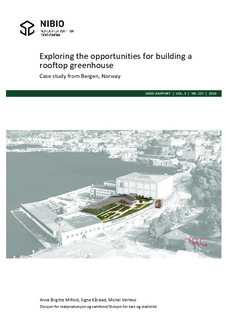| dc.description.abstract | Building greenhouses on rooftops in cities has several advantages. Shorter distance to consumers gives fresher products and less financial expenses and pollution from transport and storage. This is particularly important in cities located far away from where the food is produced. Rooftop greenhouses in cities can also give the urban population the opportunity to learn more about how food is produced. Building greenhouses on roofs instead of on the ground saves space that can instead be used for agriculture, green space or other types of housing. A rooftop greenhouse integrated with the building below can use excess heat from this building, which saves energy.
An increasing number of rooftop greenhouses have been built in cities around the world. Some of these greenhouses are commercial and sell what they produce through supermarkets, restaurants, their own shops or food box schemes. Some rooftop greenhouses are also built for universities and schools, and are used for educational purposes. Most of these greenhouses use hydroponic systems for irrigation and fertilization of the plants.
But building a rooftop greenhouse has certain challenges. If the greenhouse is to be built on an existing building it might not have the carrying capacity for an extra floor. This requires strengthening of the building, which can be expensive. Other factors which will increase the costs compared to a greenhouse on ground is building access to the greenhouse and integrating it with the building below for exchange of heat and air. It can also be difficult to get permission to build a greenhouse on a rooftop in a city centre for aesthetical reasons and because regulations only permit a certain number of floors on buildings in the area. Getting an exemption from these rules can be a challenge. In addition, it might be necessary to pay rent for the area that the greenhouse is built on. To compensate for these higher costs a rooftop greenhouse can generate extra income from a higher willingness to pay among consumers, for instance because it provides fresher products, or because the greenhouse is seen as a local, environmentally friendly concept generating employment in the neighbourhood. Other activities such as guided tours and education can help make the greenhouse more than just a commercial producer. Direct sales to consumers through its own shop or restaurant or a food box scheme can also increase income, as a larger share of the final price goes to the producer.
In this project three researchers have collaborated with a group consisting of architects, real estate companies, gardeners, chefs and representatives for local authorities, as well as the Bergen City Farmer. Preliminary results have been presented and discussed throughout the project period. A case study analysis has been developed based on the building “Bontelabo” in the centre of Bergen, looking at costs and market opportunities. The case study includes architect designed drawings.
The project shows that building a rooftop greenhouse involves extra investment costs compared with a greenhouse on the ground. But an increased focus on the social and environmental advantages of rooftop greenhouses can give both increased opportunities for investment support, for example from public authorities, and higher willingness to pay among consumers for the greenhouse products. This may increase opportunities for profitability. With an increased focus on climate change and extreme weather events we can except increased appreciation of the advantages that rooftop greenhouses have for the environment, and for the possibilities for cities to produce their own food. | en |
